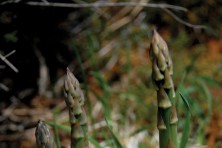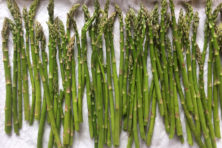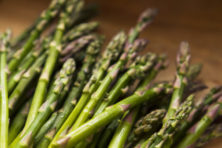Saving Your Asparagus
- Share
- Tweet
- Pin
- Share

Asparagus shoots emerging from the soil is an indication that spring has (finally) arrived. This perennial plant is common in both gardens and growing wild along roadsides.
Asparagus spears (shoots) are harvested by snapping them off at the base when they are 5-8 inches long. The plants will continue to send up shoots, which can be harvested. In order for the plant to survive, however, harvest must stop in the mid-summer to allow for the plant to mature and store enough energy in its roots to survive the winter.
In an established asparagus bed (four years old or older), harvest can continue for about 8-10 weeks, with July 4 being a typical stopping date.
Once left to mature, the asparagus spears will elongate into a tall plant with fern-like foliage.
Asparagus is dioecious, meaning there are separate male and female plants. When mature, female plants will produce red, circular berries, whereas the male plants will not have berries.

An adult common asparagus beetle. Photo by Clemson University, USDA Cooperative Extension Slide Series, Bugwood.org.
Asparagus has two common insect pests: the common asparagus beetle, Crioceris asparagi, and the spotted asparagus beetle, Crioceris duodecimpunctata. While both beetles may be present at the same time, the common asparagus beetle is more damaging and can cause undesirable, “wormy” shoots tips, so it is important to be able to know which is which and take action accordingly.
Both the common and spotted asparagus beetle adults are around ¼ of an inch long. The common asparagus beetle has a black head, an orange segment behind its head, and black abdomen with six off-white spots. The spotted asparagus beetle is red-orange with 12 black spots on its back.
Do not confuse beneficial ladybugs/lady beetles with the spotted asparagus beetle. While both are reddish with black spots, lady beetles are round, dome-shaped beetles and often have a black head. The spotted asparagus beetle is completely red-orange and oval-shaped.
Immatures (larvae) of both the common and spotted asparagus beetles look like small slugs with wrinkle-like segmentation. Common asparagus beetle larvae have gray bodies with a dark head. Spotted asparagus beetle larvae are orange.
Eggs of both species are around 1/8 of an inch long, rod-shaped, and darkly colored. The common asparagus beetle frequently lays eggs in rows directly on asparagus spears, whereas the spotted asparagus beetle lays eggs singly, often on the ferns.
Both species of asparagus beetles overwinter in plant debris as adult beetles, and become active in the spring when the asparagus shoots being to emerge. Common asparagus beetle adults and larvae feed primarily on spears and ferns. The spotted asparagus beetle typically emerges a bit later and mostly feeds on asparagus berries. There can be two to three generations of each species per year.
Infested asparagus spears often are disfigured, have eggs visually present along the spear, or contain larvae within the tip of the spear. Late-season feeding is primarily to the ferns, and very high populations can result in defoliation. If the plant is defoliated, it is unable to store as much energy in its root system for the winter and in severe cases could lead to plant death. Feeding on the berries does not affect the survival of the plant.
Because the spotted asparagus beetle primarily feeds on asparagus berries, it is not necessary to control them. The common asparagus beetle, on the other hand, can potentially cause enough damage that it is worth evaluating if some type of treatment is necessary.
Options for controlling common asparagus beetles in a small garden include picking the beetles off the plant and dropping them into a bucket of soapy water. This will need to be repeated frequently. Also, inspecting asparagus shoots and scraping off any eggs can reduce the beetle population. Removing plant residue around the asparagus patch in the late fall removes overwintering sites for both species of asparagus beetle, leading to lower populations the next spring.
Asparagus spears with eggs on them can be scraped off and are safe to eat. Likewise, if the tip of the spear contains beetle larvae, it can be cut off and the rest of the spear is fine.
In the rare situation that an insecticide application is needed, make sure to carefully read the entire pesticide label before purchase and before use. All pesticides have a printed pre-harvest interval which is the amount of time required between the application and when the crop can be harvested. Because asparagus is harvested so frequently, any insecticide used should be labeled for use on asparagus and have a very short pre-harvest interval. If there are sections of an asparagus patch that has a higher infestation of common asparagus beetles, using an insecticide in just that area can be effective. Insecticides should also not be used if there are bees or other pollinators present.
Common asparagus beetle populations can have upwards of 70 percent mortality due to an extremely tiny wasp, Tetrastichus asparagi, which lays its eggs within asparagus beetle eggs, parasitizing them. These wasps are less than 1/8 of an inch long and metallic green. If you look closely, you might be able to see some of these wasps at work in your asparagus patch. Insecticides will kill these wasps as well, so only use insecticides if absolutely necessary and don’t treat the entire patch at once.
Happy harvesting!



